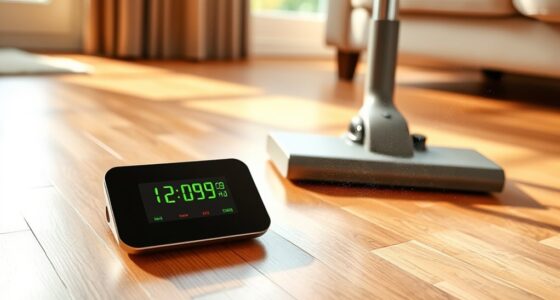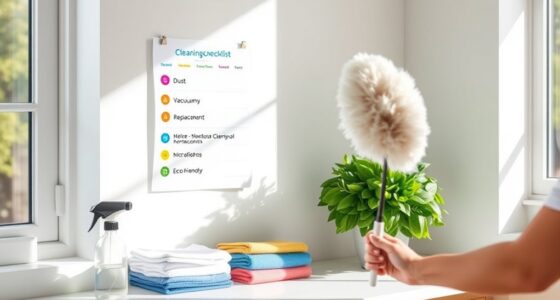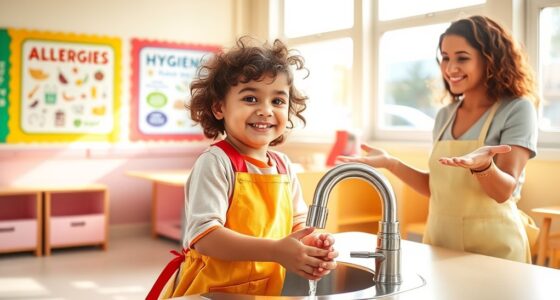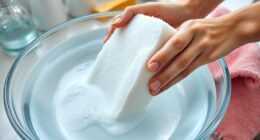To keep your baby’s crawling zone hygienic, vacuum regularly with a powerful cleaner that has strong suction and HEPA filters to trap allergens. Focus on high-traffic and favorite areas, and make sure to empty the canister often to prevent dust escape. Complement vacuuming with an air purifier to improve air quality and decrease airborne irritants. Maintaining your vacuum and scheduling professional carpet cleaning twice a year will help create a safer space for your little explorer. Keep going to find out more tips to assure a healthier environment.
Key Takeaways
- Prioritize vacuuming high-traffic and baby’s play areas daily to remove dust, dirt, and allergens effectively.
- Use a vacuum with strong suction and HEPA filters to capture microscopic particles and improve air quality.
- Regularly empty vacuum canisters or replace bags to prevent dust escape and maintain optimal performance.
- Incorporate professional deep cleaning of carpets twice a year for thorough sanitation of crawling zones.
- Complement vacuuming with air purifiers to reduce airborne allergens and create a safer, cleaner environment for your baby.

Creating a clean and safe space for your baby to crawl is vital, and regular vacuuming plays a key role in achieving that. When you prioritize vacuuming, you’re removing dust, dirt, and allergens that can settle into carpets and rugs, reducing the risk of irritation or respiratory issues for your little one. An effective vacuum cleaner with strong suction is a must, especially one that can handle carpets thoroughly. Carpet cleaning isn’t just about appearance; it’s about health. A deep clean removes embedded debris and improves indoor air quality, making your home safer for your crawling baby.
In addition to vacuuming, investing in an air purifier can notably enhance the environment where your baby spends time. An air purifier helps filter out airborne particles like pollen, pet dander, and dust mites, which are often stirred up during vacuuming or naturally circulate in the air. This creates a cleaner, fresher space, especially important if your baby has allergies or asthma. Combining regular carpet cleaning with an air purifier ensures that both surfaces and the air your baby breathes are as clean as possible.
When you vacuum, pay special attention to high-traffic areas and places where your baby spends the most time. These areas tend to accumulate more dirt and allergens, so a thorough job here makes a real difference. Consider using a vacuum with HEPA filters, which trap microscopic particles that can trigger allergies or respiratory issues. Remember to empty the vacuum canister or replace the bag frequently to prevent dust from escaping back into the environment.
Carpet cleaning should be a routine part of your home maintenance, especially in the zones where your baby crawls. You might opt for professional carpet cleaning twice a year for a deep, detailed clean, but daily vacuuming is essential for ongoing upkeep. Be sure to check that your vacuum’s filters are clean and replaced regularly, as clogged filters diminish suction power and reduce cleaning effectiveness. Proper vacuum technology plays a significant role in maintaining a hygienic environment.
Creating a safe and hygienic crawling zone isn’t only about vacuuming; it also involves maintaining good air quality through an air purifier. Together, these measures help eliminate allergens and contaminants that could affect your baby’s health. Regular carpet cleaning combined with proper vacuuming and air filtration creates an environment where your baby can explore freely and safely. It’s a proactive way to protect their health while giving you peace of mind that you’re doing everything you can to keep their space clean and secure.
Frequently Asked Questions
How Often Should I Vacuum in Baby Crawling Zones?
You should vacuum your baby’s crawling zones at least twice a week to maintain a clean environment. A consistent vacuuming schedule helps reduce dust, dirt, and allergens that can accumulate on carpets and floors. For high-traffic areas or if your baby has allergies, consider increasing the carpet cleaning frequency to three times weekly. Regular vacuuming guarantees a safer space for your little one to crawl and explore comfortably.
What Type of Vacuum Is Safest for Baby Areas?
When choosing a vacuum for baby crawling zones, safety is key. Opt for a model with low vacuum noise, so it doesn’t startle your little one. Cordless vacuums are more maneuverable and reduce tripping hazards, making them safer around crawling babies. Make sure the vacuum has a HEPA filter to trap allergens and avoid harsh chemicals. This way, you clean effectively without compromising your baby’s health or safety.
Can Vacuuming Help Remove Hidden Allergens Effectively?
Imagine a gentle whirlwind sweeping across your floors, lifting airborne allergens and carpet debris with each pass. Vacuuming actively pulls out hidden irritants lurking deep in fibers, making your home safer. It’s an effective way to reduce allergens like pet dander, dust mites, and pollen, ensuring cleaner air and a healthier environment. Regular vacuuming transforms your space into a fresh haven, especially vital for your little crawler’s sensitive developing lungs.
Is It Necessary to Use Special Filters in Vacuum Cleaners?
Using special filters in your vacuum cleaner is definitely necessary, especially if you’re concerned about allergies or dust. Look for models with allergy filters or HEPA filters, which trap tiny particles and improve air quality. Pairing your vacuum with an air purifier can further reduce allergens in the air. This combo helps keep your baby’s crawling zone cleaner, safer, and more hygienic, giving you peace of mind.
How Do I Prevent Dust From Spreading During Vacuuming?
To prevent dust from spreading during vacuuming, focus on airflow optimization and proper vacuum placement. Keep the vacuum’s hose and attachments close to the surface, and avoid lifting it high off the ground. Cover vents and doorways to contain dust, and vacuum slowly to maximize dirt pickup. Regularly change filters and bags to maintain efficiency. These steps help minimize dust dispersal, creating a cleaner, healthier environment for your baby.
Conclusion
By vacuuming regularly in your baby’s crawling zones, you create a safe, clean space where your little one can explore without worry. Some might think it’s a hassle or unnecessary, but think of it as protecting their tiny hands and knees from hidden dust and allergens. With just a quick daily routine, you’ll give your baby a healthier environment—so you can relax knowing they’re safe, happy, and free to crawl to new discoveries every day.









